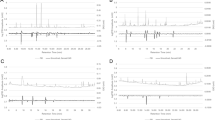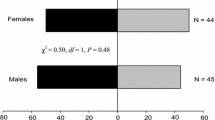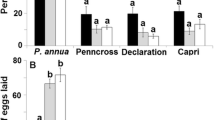Abstract
The western tarnished plant bug, Lygus hesperus Knight, feeds and develops on a variety of weeds in the spring, with later generations moving to alfalfa and cotton where severe damage to reproductive structures can occur. A synthetic attractant for monitoring or mass-trapping L. hesperus, or the identification of potential attractants for natural enemies, would be useful tools for integrated pest management programs. Studies investigated the response of naive and experienced fifth-instar and adult L. hesperus to odors associated with conspecifics and alfalfa, Medicago sativa L. Fifth-instar L. hesperus responded to all plant/insect combinations, whereas female L. hesperus only responded preferentially to vegetative and flowering alfalfa where conspecifics had fed for 24–72 hr, and to vegetative alfalfa where conspecifics were added approximately 30 min before the test began. Males were not attracted to headspace volatiles from any of the alfalfa treatments. Analysis of headspace volatiles showed that (E)-2-hexanal, (Z)-3-hexen-1-ol, α-pinene, (Z)-3-hexenyl acetate, (E)-2-hexenyl acetate, limonene, (Z)-ocimene, (E)-β-ocimene, linalool, (3E)-4,8-dimethyl-1,3,7-nonatriene, and (E, E)-α-farnesene are emitted from both vegetative and flowering alfalfa. Indole and (3E, 7E)-4,8,12-trimethyl-1,3,7,11-tridecatetraene were only detected in flowering alfalfa. Damage to alfalfa by L. hesperus increased emissions of (Z)-ocimene, (E)-β-ocimene, (E)-β-caryophyllene, and (E, E)-α-farnesene, while β-pinene, myrcene, methyl salicylate, and (3E, 7E)-4,8,12-trimethyl-1,3,7,11-tridecatetraene were only detected from damaged plants. Thus, individual or mixtures of these alfalfa volatiles may be useful as attractants for capturing nymphs and adult females of L. hesperus in the field.
Similar content being viewed by others
REFERENCES
Agelopoulos, N. G. and Keller, M. A. 1994. Plant-natural enemy association in the tritrophic system, Cotesia rubecula-Pieris rapae-Brassicae (Cruciferae) I: Sources of infochemicals. J. Chem. Ecol. 20:1725-1748.
Agusti, N. and Cohen, A. C. 2000. Lygus hesperus and L. lineolaris (Hemiptera: Miridae), phy-tophages, zoophages, or omnivores: Evidence of feeding adaptations suggested by the salivary and midgut digestive enzymes. J. Entomol. Sci. 35:176-186.
Aldrich, J. R., Lusby, W. R., Kocansky, J. P., Hoffman, M. P., Wilson, L. T., and Zalom, F. G. 1988. Lygus bug pheromone vis-à-vis stink bugs. Proc. Beltwide Cotton Conf. 213-216.
Birkett, M. A., Campbell, C. A. M., Chamberlain, K., Guerrieri, E., Hick, A. J., Martin, J. L., Matthes, M., Napier, J. A., Pettersson, J., Pickett, J. A., Poppy, G. M., Pow, E. M., Pye, B. J., Smart, L. E., Wadhams, G. H., Wadhams, L. J., and Woodcock, C. M. 2000. New roles for cis-jasmone as an insect semiochemical and in plant defense. Proc. Natl. Acad. Sci. USA 97:9329-9334.
Chinta, S., Dickens, J. C., and Aldrich, J. R. 1994. Olfactory reception of potential pheromones and plant odors by tarnished plant bug, Lygus lineolaris (Hemiptera: Miridae). J. Chem. Ecol. 20:3251-3267.
Dicke, M. and Sabelis, M. W. 1988. How plants obtain predatory mites as bodyguards. Neth. J. Zool. 38:148-165.
Groot, A. T., Drijfhout, F. P., Heijboer, A., Van Beek, T. A., and Visser, J. H. 2001. Disruption of sexual communication in the mirid bug Lygocoris pabulinus by hexyl butanoate. Agric. Forest Entomol. 3:49-55.
Groot, A. T., Timmer, R., Gort, G., Lelyveld, G. P., Drijfhout, F. P., Van Beek, T. A., and Visser, J. H. 1999. Sex-related perception of insect and plant volatiles in Lygocoris pabulinus. J. Chem. Ecol. 25:2357-2371.
Gueldner, R. C. andPARROTT, W. L. 1978. Volatile constituents of the tarnished plant bug. Insect Biochem. 8:389-391.
Gupta, A. P. 1961. A critical review of the studies of the so-called stink or repugnatorial glands of Heteroptera with further comments. Can. Entomol. 93:482-486.
Heath, R. R. and Manukian, A. 1994. An automated system for use in collecting volatile chemicals released from plants. J. Chem. Ecol. 20:593-607.
Hedin, P. A., Parrott, W. L., Tedders, W. L., and Reed, D. K. 1985. Field responses of the tarnished plant bug to its own volatile constituents. J. Miss. Acad. Sci. 30:63-66.
Ho, H. and Millar, J. G. 2002. Identification, electroantennogram screening, and field bioassays of volatile chemicals from Lygus hesperus Knight (Heteroptera: Miridae). Zool. Stud. 41:311-320.
Landis, B. J. and Fox, L. 1972. Lygus bugs in eastern Washington: Color preference and winter activity. Environ. Entomol. 1:464-465.
Leigh, T. F. 1976. Detrimental effect of Lygus feeding on plants, p. 38, in D. R. Scott and L. E. O'Keeffe (eds.). Lygus Bug: Host Plant Interactions. University Press of Idaho, Moscow, Idaho.
Leigh, T. F., Kerby, T. A., and Wynholds, P. F. 1988. Cotton square damage by the plant bug, Lygus hesperus (Hemiptera: Heteroptera: Miridae), and abscission rates. J. Econ. Entomol. 81:1328-1337.
Loper, G. M. and Lapioli, A. M. 1971. Photoperiodic effects on the emanation of volatiles from alfalfa (Medicago sativa L.) florets. Plant Physiol. 49:729-732.
Marletto, F., Manino, A., and Barbero, R. 1985. Indagini sui pronubi in coltivazioni di erba medica per la produzione di seme. Apicolt. Mod. 76:95-102.
Mattiacci, L., AmbÜhl Rocca, B., Scascighini, H., D'alessandro, M., Hern, A., and Dorn, S. 2001. Systemically induced plant volatiles emitted at the time of ″danger.″ J. Chem. Ecol. 27:2233-2252.
Mauney, J. R. and Henneberry, T. J. 1984. Causes of square abscission in cotton in Arizona. Crop Sci. 24:1027-1030.
Mclaughlin, J. R. 1998. The status of Lygus pheromone research. Proc. Beltwide Cotton Conf. Vol. 2:938-940.
Nist. 1995. Mass Spectral Library on CD-rom, Version 1.0. NIST, Gaithersburg, MD.
ParÉ, P. W. and Tumlinson, J. H. 1998. Cotton volatiles synthesized and released distal to the site of insect damage. Phytochemistry 47:521-526.
Pecetti, L. and Tava, A. 2000. Effect of flower color and sampling time on volatile emanation in alfalfa flowers. Crop Sci. 40:126-130.
Powell, W., Pennachio F., Poppy, G. M., and Tremblay, E. 1998. Strategies involved in the location of hosts by the parasitoid Aphidius ervi Haliday (Hymenoptera: Braconidae: Aphidinae). Biol. Control 11:104-112.
Rodriguez-Saona, C., Crafts-Brandner, S. J., ParÉ, P. W., and Henneberry, T. J. 2001. Exogenous methyl jasmonate induces volatile emissions in cotton plants. J. Chem. Ecol. 27:679-695.
Rodriguez-Saona, C., Crafts-Brandner, S. J., Williams, L., III, and PARÉ, P. W. 2002. Lygus hesperus feeding and salivary gland extracts induce volatile emissions in plants. J. Chem. Ecol. 28:1733-1747.
Scott, D. R. 1977. An annotated listing of host plants of Lygus hesperus Knight. ESA Bull. 23:19-22.
Sevacherian, V. and Stern, V. M. 1974. Host plant preferences of Lygus bugs in alfalfa-interplanted cotton fields. Environ. Entomol. 3:761-766.
Sevacherian, V. and Stern, V. M. 1975. Movements of Lygus bugs between alfalfa and cotton. Environ. Entomol. 4:163-165.
Strong, F. E. 1970. Physiology of injury caused by Lygus hesperus. J. Econ. Entomol. 63:808-814.
Systat, 1998. SPSS Science, Version 9. Chicago, IL.
Turlings, T. C. J., Lengwiler, U. B., Bernasconi, M. L., and Wechsler, D. 1998. Timing of induced volatile emissions in maize seedlings. Planta 207:146-152.
Turlings, T. C. J., Tumlinson, J. H., and Lewis, W. J. 1990. Exploitation of herbivore-induced plant odors by host-seeking parasitic wasps. Science 250:1251-1253.
TURLINGS, T. C. J., WÄckers, F. L., Vet, L. E. M., Tumlinson, J. H., and Lewis, W. J. 1993. Learning of host-finding cues by Hymenopterous parasitoids, pp. 51-78, in D.R. Papaj and A.C. Lewis (eds.). Insect Learning. Chapman & Hall, New York.
Wheeler, A. G., Jr. 1976. Lygus bugs as facultative predators, pp. 28-35, in D. R. Scott and O'Keeffe, L. E. (eds.). Lygus Bug: Host Plant Interactions. University Press of Idaho, Moscow, Idaho.
Whitbey, R. M. 1999. Green bean extract-induced oviposition site preference in laboratory reared western tarnished plant bug (Heteroptera: Miridae). Environ. Entomol. 28:201-204.
Zar, J. H. 1984. Biostatistical Analysis. Prentice Hall, New Jersey.
Author information
Authors and Affiliations
Rights and permissions
About this article
Cite this article
Blackmer, J.L., Rodriguez-Saona, C., Byers, J.A. et al. Behavioral Response of Lygus hesperus to Conspecifics and Headspace Volatiles of Alfalfa in a Y-Tube Olfactometer. J Chem Ecol 30, 1547–1564 (2004). https://doi.org/10.1023/B:JOEC.0000042067.27698.30
Issue Date:
DOI: https://doi.org/10.1023/B:JOEC.0000042067.27698.30




